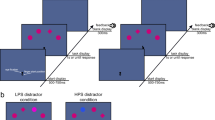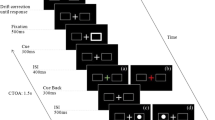Abstract
Previous research has demonstrated that when a stimulus is to be ignored, the path of motion towards a target (saccade or manual reach) deviates away from the to-be-ignored stimulus. Path deviations in saccade and reaching tasks have, however, been observed in very different situations. In the saccade tasks subjects initially attended to a cue, then disengaged attention while saccading to a target. By contrast, in the selective reaching tasks attention was continuously withdrawn from the to-be-ignored stimulus, as this was irrelevant throughout the experiment. In the two experiments reported here, cues similar to those studied in saccade tasks are examined with selective reaching procedures. Experiment 1 shows that when a coloured light-emitting diode cue, upon which subjects engage and then subsequently disengage attention, is close to the responding hand, the hand deviates away from the cue. Experiment 2 confirms this cue avoidance by showing that, compared with central fixation alone, the hand veers away from a central cue. These results confirm that the path deviations observed in saccades can also be obtained in manual reaching movements. Such findings support the notion that eye and hand movements are both affected by inhibitory mechanisms of attention.
Similar content being viewed by others
References
Abrams RA, Dobkin RS (1994) Inhibition of return: effects of attentional cuing on eye movement latencies. J. Exp Psychol Hum Percept Perform 20: 467–478
Barbieri C, DeRenzi E (1989) Patterns of neglect dissociation. Behav Neurol 2: 13–24
Biguer B, Jeannerod M, Prablanc C (1985) The role of position gaze in movement accuracy. In: Posner MI Marin OSM (eds) Attention and performance XI. Erlbaum, Hillsdale, NJ, pp 189–204
Carnahan H, Goodale MA, Marteniuk RG (1993) Grasping versus pointing and the differential use of visual feedback. Hum Mov Sci 12: 219–234
Coles MG, Gratton G, Bashore TR Eriksen CW, Donchin E (1985) A psychophysiological investigation of the continuous flow model of human information processing. J Exp Psychol Hum Percept Perform 11: 529–553
Duhamel J, Colby CO, Goldberg ME (1992) The updating of the representation of visual space in parietal cortex by intended eye movements. Science 255: 90–92
Eriksen CW (1995) The flankers task and response competition: a useful tool for investigating a variety of cognitive problems. Vis Cogn 2: 101–118
Friksen BA, Eriksen CW (1974) Effects of noise letters upon the identification of a target letter in a non-search task. Percept Psychophys 16: 143–149
Farah MJ, Wong AB, Monheit MA, Morrow LA (1989) Parietal lobe mechanisms of spatial attention: modality-specific or supramodal?. Neuropsychologia 27: 461–470
Findlay JM (1992) Programming of stimulus elicited saccadic eye movements. In: Rayner K (ed) Eye movements and visual cognition. Springer, Berlin Heidelberg New York, pp 8–31
Georgopoulos AP (1990) Neurophysiology of reaching. In: Jeannerod M (ed) Attention and performance XIII. Erlbaum, Hillsdale, NJ, pp 227–263
Georgopoulos AP, Schwartz AB, Kettner RE (1986) Neuronal population coding of movement direction. Science 233: 1416–1419
Georgopoulos AP, Kettner RE, Schwartz AB (1988) Primate motor cortex and free arm movements to visual targets in three dimensional space. II. Coding of the direction of movement by a neuronal population. J Neurosci 8: 2989–2947
Houghton G., Tipper SP (1994) A model of inhibitory mechanisms in selective attention. In: Dagenbach D, Carr TH (eds) Inhibitory processes in attention, memory and language. Academic, London, pp 53–112
Ingle D (1973) Selective choice between double prey objects by frogs. Brain Behav Evol 7: 127–142
Kalaska JF (1988) The representation of arm movements in postcentral and parietal cortex. Can J Physiol Pharmacol 66: 455–463
Kalaska JF, Caminiti R, Georgopoulos AP (1983) Cortical mechanisms related to the direction of two-dimensional arm movements; relations in parietal area 5 and comparison with motor cortex. Exp Brain Res 51: 247–260
Maylor EA (1985) Facilitatory and inhibitory components of orienting in visual space. In: Posner MI, Marin OSM (eds) Attention and performance XI. Erlbaum, Hillsdale, NJ, pp. 189–204
Miller J (1987) Evidence of preliminary response preparation from a divided attention task. J. Exp Psychol Hum Percept Perform 13: 425–434
Moran J, Desimone R (1985) Selective attention gates visual processing in the extra-striate cortex. Science 229: 782–784
Neill WT, Westberry RL (1987) Selective attention and the suppression of cognitive noise. J Exp Psychol Learn Mem Cogn 17: 1136–1145
Posner MI, Cohen YA (1984) Components of visual orienting. In: Bouma H, Bouwhis DG (eds) Attention and performance X. Erlbaum, Hillsdale, NJ, pp 531–554
Rafal RD, Calabresi PA, Brennan CW, Sciolto TK (1989) Saccade preparation inhibits reorienting to recently attended locations. J. Exp Psychol Hum Percept Perform 15: 673–685
Sheliga BM, Riggio L, Rizzolatti G (1994) Orienting of attention and eye movements. Exp Brain Res 98: 507–522
Sheliga BM, Riggio L, Rizzolatti G (1995) Spatial attention and eye movements. Exp Brain Res 105: 261–275
Simon JR (1990) The effects of an irrelevant directional cue on human information processing. In: Proctor RW, Reeve TG (eds) Stimulus-response compatibility. Elsevier, North-Holland, pp 31–86
Simon JR, Craft JL, Webster JB (1971) Reaction time to onset and offset of lights and tones: reactions toward the changed element in a two-element display. J Exp Psychol 89: 197–202
Stroop JR (1935) Studies of interference in serial verbal reactions. J Exp Psychol 18: 643–662
Tipper SP (1985) The negative priming effect: inhibitory priming by ignored objects. Q J Exp Psychol [A] 37: 571–590
Tipper SP, Driver J, Weaver B (1991) Object-centered inhibition of return of visual attention. Q J Exp Psychol [A] 37: 591–611
Tipper SP, Lortie C, Baylis GC (1992) Selective reaching: evidence for action-centered attention. J Exp Psychol Hum Percept Perform 18: 891–905
Tipper SP, Weaver B, Houghton G (1994) Behavioral goals determine inhibitory mechanisms of selective attention. Q J Exp Psychol [A] 47: 809–840
Tipper SP, Howard LA, Jackson SR (in press) Selective reaching to grasp: Evidence for distractor interference effects. Vis Cogn
Warren WH, Whang S (1987) Visual guidance of walking through apertures: body-scaled information for affordances. J Exp Psychol Hum Percept Perform 13: 371–383
Author information
Authors and Affiliations
Corresponding author
Rights and permissions
About this article
Cite this article
Howard, L.A., Tipper, S.P. Hand deviations away from visual cues: Indirect evidence for inhibition. Exp Brain Res 113, 144–152 (1997). https://doi.org/10.1007/BF02454150
Received:
Accepted:
Issue Date:
DOI: https://doi.org/10.1007/BF02454150




